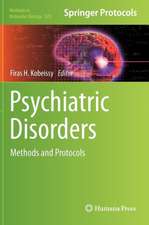Animal Models of Pain: Neuromethods, cartea 49
Editat de Chao Ma, Jun-Ming Zhangen Limba Engleză Hardback – 11 oct 2010
| Toate formatele și edițiile | Preț | Express |
|---|---|---|
| Paperback (1) | 695.70 lei 43-57 zile | |
| Humana Press Inc. – 23 aug 2016 | 695.70 lei 43-57 zile | |
| Hardback (1) | 950.84 lei 43-57 zile | |
| Humana Press Inc. – 11 oct 2010 | 950.84 lei 43-57 zile |
Din seria Neuromethods
- 5%
 Preț: 347.57 lei
Preț: 347.57 lei - 15%
 Preț: 659.53 lei
Preț: 659.53 lei - 15%
 Preț: 665.08 lei
Preț: 665.08 lei - 18%
 Preț: 986.63 lei
Preț: 986.63 lei - 24%
 Preț: 852.89 lei
Preț: 852.89 lei - 18%
 Preț: 953.03 lei
Preț: 953.03 lei - 18%
 Preț: 955.25 lei
Preț: 955.25 lei - 20%
 Preț: 1129.36 lei
Preț: 1129.36 lei - 20%
 Preț: 1252.04 lei
Preț: 1252.04 lei - 18%
 Preț: 1291.45 lei
Preț: 1291.45 lei - 15%
 Preț: 652.31 lei
Preț: 652.31 lei - 18%
 Preț: 955.70 lei
Preț: 955.70 lei - 23%
 Preț: 705.39 lei
Preț: 705.39 lei - 18%
 Preț: 973.38 lei
Preț: 973.38 lei - 18%
 Preț: 964.86 lei
Preț: 964.86 lei - 18%
 Preț: 968.03 lei
Preț: 968.03 lei - 15%
 Preț: 662.95 lei
Preț: 662.95 lei - 15%
 Preț: 646.43 lei
Preț: 646.43 lei - 15%
 Preț: 649.71 lei
Preț: 649.71 lei -
 Preț: 395.29 lei
Preț: 395.29 lei - 19%
 Preț: 580.67 lei
Preț: 580.67 lei - 19%
 Preț: 584.12 lei
Preț: 584.12 lei - 19%
 Preț: 566.41 lei
Preț: 566.41 lei - 15%
 Preț: 652.17 lei
Preț: 652.17 lei - 15%
 Preț: 655.13 lei
Preț: 655.13 lei - 18%
 Preț: 959.36 lei
Preț: 959.36 lei - 15%
 Preț: 652.49 lei
Preț: 652.49 lei - 15%
 Preț: 649.54 lei
Preț: 649.54 lei - 15%
 Preț: 649.87 lei
Preț: 649.87 lei - 15%
 Preț: 650.19 lei
Preț: 650.19 lei - 15%
 Preț: 648.42 lei
Preț: 648.42 lei - 18%
 Preț: 1039.22 lei
Preț: 1039.22 lei - 18%
 Preț: 963.15 lei
Preț: 963.15 lei
Preț: 950.84 lei
Preț vechi: 1159.56 lei
-18% Nou
Puncte Express: 1426
Preț estimativ în valută:
181.94€ • 190.47$ • 150.55£
181.94€ • 190.47$ • 150.55£
Carte tipărită la comandă
Livrare economică 07-21 aprilie
Preluare comenzi: 021 569.72.76
Specificații
ISBN-13: 9781607618799
ISBN-10: 1607618796
Pagini: 230
Ilustrații: XII, 204 p.
Dimensiuni: 178 x 254 x 23 mm
Greutate: 0.6 kg
Ediția:2011
Editura: Humana Press Inc.
Colecția Humana
Seria Neuromethods
Locul publicării:Totowa, NJ, United States
ISBN-10: 1607618796
Pagini: 230
Ilustrații: XII, 204 p.
Dimensiuni: 178 x 254 x 23 mm
Greutate: 0.6 kg
Ediția:2011
Editura: Humana Press Inc.
Colecția Humana
Seria Neuromethods
Locul publicării:Totowa, NJ, United States
Public țintă
Professional/practitionerCuprins
Assessment of Pain in Animals.- Animal Models of Inflammatory Pain.- Animal Models of Visceral Pain.- Animal Models of Pain After Peripheral Nerve Injury.- Animal Models of Pain After Injury to the Spinal Ganglia and Dorsal Roots.- Localized Inflammatory Irritation of the Lumbar Ganglia: An Animal Model of Chemogenic Low Back Pain and Radiculopathy.- Animal Models of Central Neuropathic Pain.- Animal Models of Cancer Pain.- Animal Models of Diabetic Neuropathic Pain.- Animal Models of HIV-Associated Painful Sensory Neuropathy.- Animal Models of Postoperative Pain.
Recenzii
From the reviews:
“This volume specifically covers animal models used to study different types of pain. … The book has a very specific audience -- neuroscientists studying pain physiology and investigators trying to develop new pharmacological interventions for pain. It also may help clinicians to develop a better understanding of the testing methods used to develop new drugs as in relationship to their efficacies. … It covers topics that are the backbone of the understanding and management of pain.” (Tariq M. Malik, Doody’s Book Reviews, March, 2012)
“This book critically describes the recent attempts to more directly model prevalent clinical pain syndromes to increase face and predictive validity of pain modelling tools. The book encompasses a total of 11 chapters, each written by authoritative researchers in the field. … Each chapter describes in detail how the models in question are developed. … appeal to scientists interested in understanding pain mechanisms and in the preclinical development of new analgesics, as well as clinicians aiming at advancing translation pain research.” (Debby Van Dam, Clinical Neurology and Neurosurgery, January, 2011)
“This volume specifically covers animal models used to study different types of pain. … The book has a very specific audience -- neuroscientists studying pain physiology and investigators trying to develop new pharmacological interventions for pain. It also may help clinicians to develop a better understanding of the testing methods used to develop new drugs as in relationship to their efficacies. … It covers topics that are the backbone of the understanding and management of pain.” (Tariq M. Malik, Doody’s Book Reviews, March, 2012)
“This book critically describes the recent attempts to more directly model prevalent clinical pain syndromes to increase face and predictive validity of pain modelling tools. The book encompasses a total of 11 chapters, each written by authoritative researchers in the field. … Each chapter describes in detail how the models in question are developed. … appeal to scientists interested in understanding pain mechanisms and in the preclinical development of new analgesics, as well as clinicians aiming at advancing translation pain research.” (Debby Van Dam, Clinical Neurology and Neurosurgery, January, 2011)
Textul de pe ultima copertă
With the loss of work days, the price of health care and payments for compensation, litigation, and malpractice, and the overwhelming cost of human suffering, chronic pain syndromes affect humanity enormously on both an economic and personal level. In Animal Models of Pain, expert investigators in the field provide a consolidated review of the current state of pain research by capturing the diversity of animal models that are used to investigate pain mechanisms, which range from surgical incision to mechanical compression and from spinal cord injury to cutaneous/local inflammation and beyond. As a volume in the respected Neuromethods series, this book delivers its vital content through detailed descriptions of a wide variety of step-by-step laboratory methods.Authoritative and cutting-edge, Animal Models of Pain seeks to lead scientists closer to the ultimate goal of improving the quality of life and relieving the unbearable burden of chronic pain for millions of people throughout the world.
Caracteristici
Consolidates a diverse selection of animal models along with cutting-edge, lab-ready methodologies Investigates pain mechanisms ranging from surgical incision to mechanical compression and from spinal cord injury to cutaneous/local inflammation Provides practical details from leading researchers in the field Includes supplementary material: sn.pub/extras
















